NAGPUR DIVISION
NAGPUR ORANGES :- The Nagpur Speciality.

One of well known specialties of Nagpur is the world famous Nagpur orange, the cultivation of which in Vidarbha region of Maharashtra has brought indispensable glory to the region. The orange is cultivated in 80000 hectares area in Vidarbha with a total production of nearly 5 lakh tons. Nagpur orange in Nagpur district is cultivated in 20, 965 hectares area. There is an interesting story how the cultivation of Nagpur orange in this region started. The cultivation of Nagpur orange was tested for the first time as a kitchen garden plant during 1896 by Late Shri. Raghujiraje Bhonsle and observed as a successful venture. Since then, its cultivation attained momentum year after year and by now, it is claimed to be one of the most remunerative potential foreign exchange earning crops of not only this region but also as one of the horticultural crops after mango and banana at national level. An offshoot of orange industry of Nagpur is NOGA (National Orange Growers Association) in Motibagh area of Nagpur which processes and prepares besides Orange juice, 68 other items including jams, squash, marmalades ketchup, sauce, soups and baked beans etc.
DEEKSHABHOOMI :-
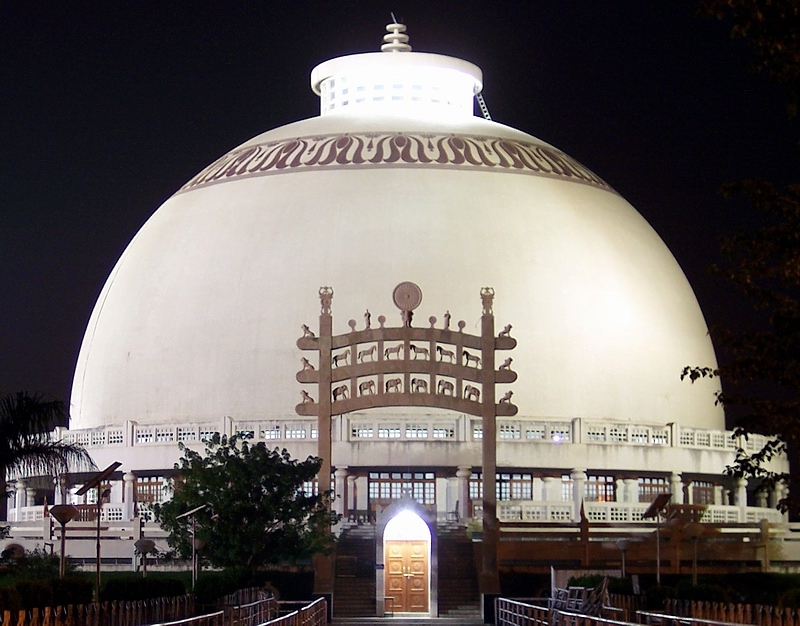
Bharat Ratna Dr B. R. Ambedkar along with lakhs of his followers embrassed Buddhism on Oct 14' 1956 at Deekshabhoomi located at western Nagpur near Ramdaspeth. Since then the site is regarded as a pilgrimage centre for Buddhist. A memorial has since been constructed at the spot. This started with construction of a Bhikshu Niwas in 1968, followed by a P/G degree college and finally a majestic towering monument consisting of replicas of gate of Sanchi Stupa, constructed at a cost of Rs. 6 crores. 5000 Bhikshu can be accomodated in each storey. The diameter and height of the dome is 120 ft. Granites, Marbles and Dholpur Sandstone have been used for the construction of this 4000 sq. ft. hall. The President of India has inaugurated this majestic monuments that is a symbol of national integration and secularism and a place of pride for Nagpurians.
THE DRAGON PALACE TEMPLE, KAMPTEE :-
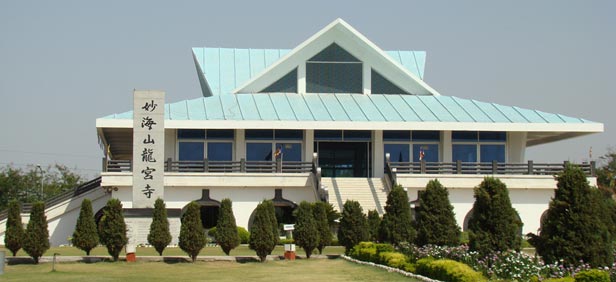
Kamptee, satellite township of Nagpur, has recently earned a scintillating identity through the magnificent Dragon palace temple. The unique Buddhist temple with its attractive architecture and landscape was inaugurated on 23 Nov' 1999 by Mother Noriko Ogawa society, Japan on the follow-up by Ms Sulekha Kumbhare.
The temple sprawls on 10 acre of land, having a serine and beautiful buddhist prayer centre. A hude idol of Lord Buddha is installed on the first floor of the Meditation hall which is carved out of a Single Sandalwood block. The temple with its characteristic architecture has already received an international award for best concrete structure. The dazzling while walls of the temple signify for peace, purity and divinity. The devotees who assemble there chant 'Nangu-Mayo-Ho-Renge-Kyo' during the meditating hours. The architechtural masterpiece of Nagpur i.e. the Dragon Palace temple is also called 'Lotus Temple' & stands tall amidst sprawling lush green lawns, dotted with flowering plants & laid down in an attractive landscape pattern. The Ogawa society which maintains the temple also looks after allied social activities which include running a mobile hospital, a welfare centre, an orphanage & a school for poor.
Buddha statue Kampthee Nagpur
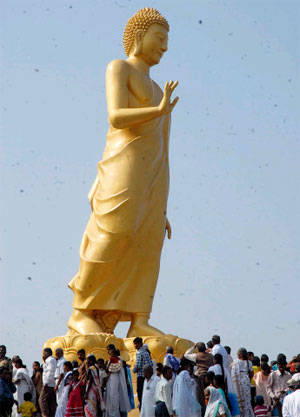
Dr. Babasaheb Ambedkar inspired his millions of his followers to become Buddhists in 1956. Despite of his untimely death in the same year, the conversion movement did not stop. As the movement remained leaderless and in the absence of response from the Buddhists abroad, Buddhists in India had less access to teachers and teachings of the Buddha. Nagaloka initiative is an important step in this direction of Buddhist teaching and training for people all over India.
The core vision of Nagaloka is to create a new society based on liberty, equality and fraternity through universal and emancipatory teachings of the Buddha.
Nagaloka is also a place for devotion and arts. This vision of the Buddhism is crystallized in the image of the Buddha that Dr. Ambedkar liked- The Buddha walking in the world, meeting people rich and poor and giving them medicines of the Dhamma.
On 13th December 2009, with the generous donation from the Buddhists in Taiwan and China, the 36 ft image of the Buddha was inaugurated in Nagaloka. The image is created by a famous sculptor, Hon. Wen Khwey, of Taiwan. He is a creative genious who brought the important qualities of the Buddha alive in the Walking Buddha image. The Buddha is walking in the world with his hand raised in Abhaya Mudra removing worst fears of humanity and assuring them confidence. The Buddha is looking compassionately at the world. His eyes are open with the quality of compassion shining through them. This is an unique image of the Buddha.
On this day, over 1,00,000 people came to witness the inauguration ceremony of the Walking Buddha. The people came from all over the places, including villages and towns and cities and from far. The day was charged with devotion as people queued to pay their respect to their ideal, the Buddha. Venerable Kuang Shin and honourable Buddhists, both monks, nuns and laities from Taiwan were present on this occasion. The ceremony of the inauguration is historic.
The Walking Buddha is now onlooking the Nagaloka premises, which is the training centre, Dhamma Hall and residential buildings for trainees and the guests coming from all over the world. The Walking Buddha making the whole Nagaloka the Buddhist Vihar. It is the main image in the Nagaloka Vihar. The devotees come everyday with flowers, incense and candles to express their devotion. The whole campus is now charged with the inspiration of the Buddha to walk into world.
JAADU MAHAL, VISHWAKARMA NAGAR, NAGPUR :- At Vishvakarma nagar, on Manewada Road is yet another unique place which can truely be called gem of Nagpur. This is a building called Jaadu Mahal (the magic place) which is constructed by famous Magician of Nagpur Late Sunil Bhavsar. This is perhaps the only magic palace in the country with its unique characterisation. In this premises various magic tricks are demonstrated. The Jaadu Mahal remains open even on sundays. Its a treat to visit this gem of Nagpur.
GANGAVATARAN SHIVA AT NANDANWAN :-
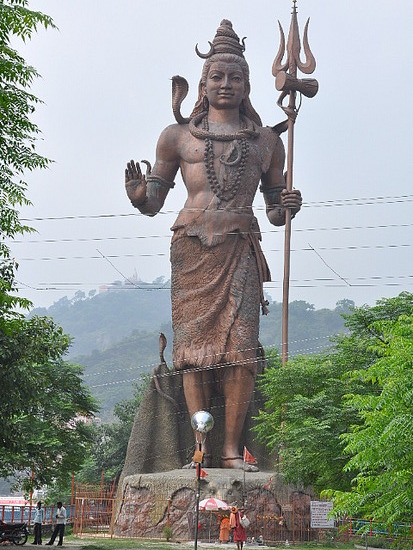
In the premise of Shri Laxmi Narayan temple located in Nandanvan area of east Nagpur, a trust of religious Nagpurian has decided to construct a 51 feet statue of Lord Shiva . The pledged gaint size statue has been designed by sculpture Shri Indrageet Sakharam Tidke of Malakoti distt. , Nanded The constructed of this unique statue has already began at the site. Once completed , this will be one of the most magnificiant statues in Vidharbha and perhaps India . It is likely to prove one of major centres of attraction at Nagpur.
Sadar Charch :
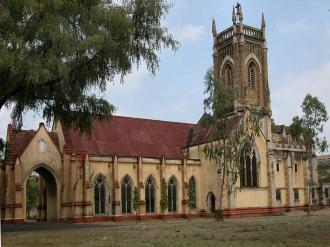
Ballalpur, Chandrapur and Manikgarh Forts
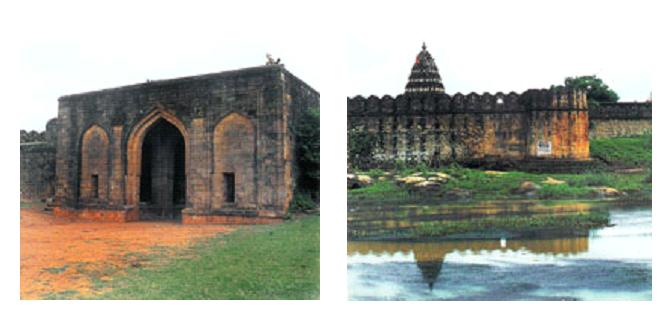
Situated in Chandrapur (old Chanda) district of Maharashtra, all the three forts are of tribal origin. Ballalpur, now known for its coal mines and paper mills, is 16kms south-eat of Chandrapur, the district headquarters, Ballalpur was the capital of the Good king Khandakya Ballalshah during 1437-62 AD. The land fort that he built here on the eastern bank of the Wardha River is square in shape with walls and bastions. There are still two intact gates set at right angle to each other. There is also a small postern gate on the river side. The fort walls are still intact, but all the old buildings are in total ruins. |
The credit for establishing Chandrapur also goes to Khandakya Ballalshah. When the capital was shifted from Ballalpur to Chandrapur, the Ballal kings built here an extensive land fort with high walls and bastions. The fort had at its four cardinal points four impressive gates. The original buildings have vanished, but the gates and a portion of the wall still exists. Chandrapur was annexed by Raghuji Bhosale of Nagpur in the middle of the 18th century. Finally the fort was captured by the Britishers in 1818 AD. Now an industrial town, Chandrapur is also famous for it s old Mahakali temple. |
Manikgarh, made famous by a newly established cement factory near by, is about 35kms south-west of Chandrapur. Built by tribal Naga kings in the 9th century, the Manigarh hill fort stands at the height of 507 metres above sea-level. It was strongly fortified with walls and bastions. There were several tanks and buildings inside the fort. Today, the fort is in complete ruins and has become a sanctuary for wild animals. A pukka road through a dense forest leads very close to the gateway of the fort. Nearby is an old temple of Vishnu. |
Tadoba National Park :
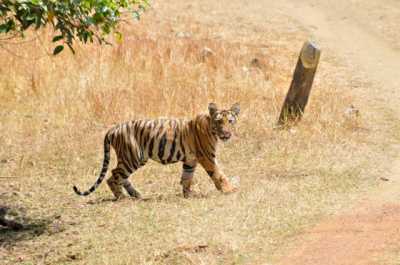
Tadoba National Park is situated in the district of Chandrapur in the north-eastern part of Often referred to as 'The Jewel of Vidharba', it is the oldest national park in Maharashtra.
The Park gets its name from the local tribal God, 'Taru'. According to the legend Taru was a village chief who was killed in an epic fight with a tiger, and the local villagers started worshiping him as the deity of 'Tadoba'.
The park was established in 1935 and declared as a National Park in 1955 and since 1995, the area comprising the Tadoba National Park and Andhari wildlife Santuary together was designated as Tadoba-Andhari Tiger Reserve. It is the second Tiger Reserve in the State. The area of the Reserve is 625.40 sq. km. This includes Tadoba National Park, created in 1955 with an area of 116.55 sq. km and Andhari Wildlife sanctury created in 1986 with an area of 508.85 sq. km.
The Reserve is constituted with 577.96 sq. km. Reserve Forest, 32.51 sq. km. Protected Forest and 14.93 sq. km. other areas. The national park inside the reserved forest, boasts of more than thousand species of birds, animals, insects and other life forms.
The park is covered with the rich, dry, deciduous forests, populated with Sal, Ain, Tendu, Mahua, Haldu, Semal, Mango and Bamboo, particularly around the artificial Tadoba Lake. Andhari river flows through the forest.
The park consists around 50 Bengal Tigers Along with this other frequently spotted wildlife are Sambar, Gaur, Chinkara, Leopard cat, Pangolin, Panther, Spotted deer, Sloth bear, Chausinga, Nilgai, Barking deer, Indian bison, Wild dog, Hyena, Jackals etc. Late nights are best to see Tigers, Leopards, Gaur, Nilgai, Sambar and Chital.
Tadoba National Park also an ornithologist's paradise with a varied diversity of Migratory birds and Water Birds. Python, Bengal monitor lizard and crocodiles are other inhabitants of this park.
The park has facilities for tourists to stay overnight. The main attraction in the park is the Jungle Safari which attracts large number of tourists. A permit is required for the safari. A 12-seater minibus is available at Tadoba for the safari. A motorable road goes round the Tadoba lake.
The park is open through out the year and closed every Tuesday.
Timings : 6.00 am to 11.00 am and 3.00 pm to 6.00 pm

.HOME








